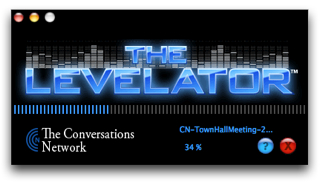(This is the first in an on-going series detailing the inner workings of new media projects — Douglas)
This is Michael Lawshé , an old and new media person.
I was recently approached by an old media producer to work on a new media project.
Sound for a flash animation web animation series project. They were going to write, direct and produce 4 short – [3-5 minute] pieces to be released on the web at a later date. I’ve done many cartoons and animated movies – I said I’d help. I got the script. I was asked for advice. I described the pyramid.

OK, so they wanted to cast and record the actors FAST.
They wanted it to be GOOD.
They needed it to be CHEAP.
I suggested either:
1: Record each actor separately – direct them individually, record on a computer, maybe?
– cheap not very good and not fast.
2: Book a sound stage with a microphone on each actor so all could read and react to each other – multitrack record it [each character on own track] and hand over an editable session.
– very good and very fast not cheap.
3: Record as best you can maintaining equivalent distances from the microphones with each character – AT LEAST IN SEPARATED TRACKS FOR EACH MIC!
– not very good and not very fast but pretty cheap. {UP FRONT!}
Well – they chose the latter – this has meant a TON of post editing and audio noise reduction, and leveling and overlaps in their takes. One Mic has a 60 cycle ground loop buzz on it – and much of the audio is a bit off mic and fairly low level. {sigh}.
I used my editing system, imported the tracks in and cut the pieces, exported them to the desktop as .wav 48khz 16 bit files. Then used itunes to convert them to .aiff 44.1khz files for a cd then high quality .mp3 files {with trepidation} for the animator. {MP3 files can run at a different speed and the quality is much lower.}
The animator and I should have talked early on, but we didn’t have a chance.
1. Get a checklist to talk to the animator first!
2. Check on the specs for final delivery and for prep of the project.
3. Get the movie files all the same rate/ codec/ file type / aspect size
4. Have the animator/ editor keep a list of audio track moves and edits – an editorial edit decision list if possible [edl]
I was delivered 4 quicktime movies of differing, sometimes unknown size, screen ratio and encoding codec. Each would preview play on the computer, and had audio on it. When I used apple’s QT inspector it said “unknown codec”. 12 frames per second. Never saw that one before!
OK. Called the animator and he says “Oh, I did it in “flash”” Um, yeah.. 12 fps!”
“OK, is it NTSC?”
“It’s flash”
“{sigh}“
OK I had to purchase QT Pro and up converted them to H264 and .mov files but THEY ARE STILL ALL DIFFERENT FRAME SIZES!!
Then and only then I could extract the audio to use it as a guide track – pull up and “Phase” up – pull into synch – the dozens of audio moves that were done in each episode.
Now, I’m in the process of removing hums, adding reverb, and placing and editing music {it’s here!} and sound effects into each piece.
Initial recording in a music studio – 2 mics – 4 – 6 hours
CHEAP – not too good not fast
Pick ups re recording a different character professional stage – 1 hour
GOOD – FAST – not cheap
Editing original dialog tracks – 12-15 hours
RE-Editing original dialog tracks to animation without notes – 6 hours
Cleaning up tracks each episode – 2 hours
Editing music tracks – 2 hours
Sound effects placement choice editing mix – So far 4-6 hours per show
I’m working CHEAP
– and it IS GOOD.
– But, boy, oh boy…. it’s NOT FAST!!
Filed under: News, Real World Example

 Wednesday, June 25, 2008
Wednesday, June 25, 2008






